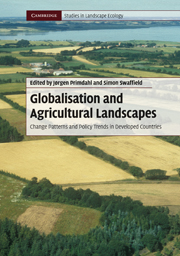Book contents
- Frontmatter
- Contents
- List of Contributors
- Preface
- 1 Globalisation and the sustainability of agricultural landscapes
- 2 Agricultural liberalisation, multifunctionality and the WTO: competing agendas for the future of farmed landscapes
- 3 Globalisation of agricultural landscapes: a land systems approach
- 4 Agricultural landscape changes through globalisation and biodiversity effects
- 5 Swiss agricultural policy reform: landscape changes in consequence of national agricultural policy and international competition pressure
- 6 Local landscape consequences of macro-scale policy reform: the New Zealand experiment
- 7 Rural landscape differentiation in the face of changing demands and policies: a typology of rural areas in Portugal
- 8 Globalisation and the local agricultural landscape: current change patterns and public policy interventions
- 9 From totalitarian to democratic landscapes: the transition in Estonia
- 10 Rural landscape change as a product of US federal policy
- 11 New approaches for urban–rural areas in Dutch spatial planning
- 12 Restoring agricultural landscapes in shrinking cities: re-inventing traditional concepts in Japanese planning
- 13 Globalisation and local agricultural landscapes: patterns of change, policy dilemmas and research questions
- Index
- References
13 - Globalisation and local agricultural landscapes: patterns of change, policy dilemmas and research questions
Published online by Cambridge University Press: 05 June 2012
- Frontmatter
- Contents
- List of Contributors
- Preface
- 1 Globalisation and the sustainability of agricultural landscapes
- 2 Agricultural liberalisation, multifunctionality and the WTO: competing agendas for the future of farmed landscapes
- 3 Globalisation of agricultural landscapes: a land systems approach
- 4 Agricultural landscape changes through globalisation and biodiversity effects
- 5 Swiss agricultural policy reform: landscape changes in consequence of national agricultural policy and international competition pressure
- 6 Local landscape consequences of macro-scale policy reform: the New Zealand experiment
- 7 Rural landscape differentiation in the face of changing demands and policies: a typology of rural areas in Portugal
- 8 Globalisation and the local agricultural landscape: current change patterns and public policy interventions
- 9 From totalitarian to democratic landscapes: the transition in Estonia
- 10 Rural landscape change as a product of US federal policy
- 11 New approaches for urban–rural areas in Dutch spatial planning
- 12 Restoring agricultural landscapes in shrinking cities: re-inventing traditional concepts in Japanese planning
- 13 Globalisation and local agricultural landscapes: patterns of change, policy dilemmas and research questions
- Index
- References
Summary
Introduction
The rich diversity of agricultural landscapes within developed economies that have evolved around the world over sometimes thousands of years are now becoming more and more interconnected. The local agents who manage these landscapes – farmers, other landowners, managers and communities – are increasingly part of a global network society (Castells, 2000), made up of transnational organisations, rapidly changing global markets and international policy imperatives, linked through new technologies (Stringer and Le Heron, 2008). The interrelatedness of local landscape change with the processes of globalisation was illustrated in the opening chapter of this volume through an account of two dairy farmers on opposite sides of the world, each affected in various ways by the intersecting dynamics of market liberalisation and sustainability agendas.
The farmers' situation was described on a November morning in 2007. In the 12 months that followed, much happened in the global network society of which they are both part. A global financial crisis led to economic recession in developed and developing countries, and as a consequence, the two farmers had to deal with increasingly volatile market conditions for their products, currency fluctuations and a rapid change in the environment for new investment. Both farmers experienced a sharp introduction to the moral economy of food (Marsden, 2003; Morgan et al., 2007), when the cooperatives to whom they supply milk were both affected by a food safety scandal in China involving contamination of milk powder, which affected the lives and health of thousands of babies.
- Type
- Chapter
- Information
- Globalisation and Agricultural LandscapesChange Patterns and Policy trends in Developed Countries, pp. 245 - 270Publisher: Cambridge University PressPrint publication year: 2010
References
- 4
- Cited by

